Every Super Smash Bros. Ultimate Character’s First Appearance
Mario – Donkey Kong (Arcade, 1981)
Mr. Video himself. Mario’s first appearance was in the 1981 arcade game Donkey Kong, in which he wasn’t even called Mario. Instead, he was known simply as ‘Jumpman.’ It wasn’t until Mario Bros. where he finally donned the famous name that the world knows him for today.
Donkey Kong – Donkey Kong (Arcade, 1981)
Donkey Kong starred alongside Mario as the damsel in distress-kidnapping villain in the original Donkey Kong. Although the character first made his appearance in that game, it was later revealed that that particular Donkey Kong was actually Cranky Kong from the Donkey Kong Country series. The tie-wearing DK in Super Smash Bros. is actually the Donkey Kong from Donkey Kong Country —Cranky’s grandson.
Link – The Legend of Zelda (NES, 1986)
The hero of The Legend of Zelda was, in fact, not named Zelda but Link. Although Link serves as the protagonist of every main Zelda game, it is not the same person each time. Super Smash Bros. Ultimate’s Link is that of the latest game in the series: Breath of the Wild.
Samus – Metroid (NES, 1986)
Samus’ bounty hunting began in 1986’s Metroid. In the original game, she is sent to the planet Zebes to track down the space pirates. While exploring the claustrophobic environments, she takes down many of the series’ staple villains, including Ridley, Kraid and Mother Brain.
Dark Samus – Metroid Prime (GameCube, 2002)
Dark Samus is the main antagonist in Metroid Prime 2: Echoes, but she also makes a very brief appearance in the first 3D Metroid game. If you finish Metroid Prime 100%, you are treated to an extra cutscene where you witness the birth of Dark Samus.
Yoshi – Super Mario World (SNES, 1990)
In Super Mario World, Mario could find one of the many dinosaurs known as Yoshi inside of an egg and ride on top of one. In 1995, this lovable companion received his own game, Yoshi’s Island, which branched off into its own series.
Kirby – Kirby’s Dream Land (Game Boy, 1992)
Due to the monochrome display of the Game Boy, the famous pink puff Kirby started off its life as a white puff. It wasn’t until Kirby’s NES game, Kirby’s Adventure, that the character took on its more recognizable color and gained the ability to copy foes’ abilities.
Fox – Star Fox (SNES, 1993)
In 1993, 3D games on home consoles were not a regular occurrence. Star Fox utilized a technology known as the Super FX chip to create a game much more powerful than the SNES was capable of, and although rather primitive looking today, it was quite a revolution in 1993. Not only was it impressive, but Fox’s first outing was also a pretty fun on-rails shooter.
Pikachu – Pokemon Red, Green & Blue (Game Boy, 1996)
Despite Pikachu’s debut occurring just three years before the original Super Smash Bros., the electric mouse Pokemon was already popular enough to warrant a spot in that game’s starting roster. This was definitely thanks in part to its role as Ash’s main partner in the anime. In Pokemon Red, Green & Blue, Pikachu was actually quite rare, having a very low chance to appear in Viridian Forest and the Power Plant.
Luigi – Mario Bros. (Arcade, 1983)
Not only did Mario get his name from 1983’s Mario Bros., but the game also saw the first appearance of Mario’s brother Luigi. Although, he debuted as literally just a green version of Mario.
Ness – Earthbound (SNES, 1994)
Possibly the most obscure character from the original Super Smash Bros., Ness comes from the SNES RPG Earthbound. It was the first (and only) game from the series to be released in North America and is known in Japan as Mother 2.
Captain Falcon – F-Zero (SNES, 1990)
It can be argued that Captain Falcon is even more obscure than Ness as he doesn’t really appear in his original game at all. He is the pilot of the Blue Falcon and can only be seen in a manga contained within F-Zero’s manual. It wasn’t until F-Zero X that we finally got to see this racer in-game in the form of character art.
Jigglypuff – Pokemon Red, Green & Blue (Game Boy, 1996)
The second pink puff to appear in Super Smash Bros. Jigglypuff is also a popular character in the first season of the Pokemon anime. In Pokemon Red, Green & Blue, it can be found as early as Route 3.
Peach – Super Mario Bros. (NES, 1985)
Peach (originally known as Princess Toadstool) was one of the first new characters to be shown off for Super Smash Bros. Melee. In Super Mario Bros., it was Mario’s job to rescue her from the clutches of King Koopa. Peach’s first playable appearance was 1992’s Super Mario Kart.
Daisy – Super Mario Land (Game Boy, 1989)
Daisy is the princess of Sarasaland. In Super Mario Land, she played a similar role to Peach did in Super Mario Bros.; it was Mario’s job to rescue her from the clutches of Tatanga. Following this game, she has only ever appeared in Mario spin-offs.
Bowser – Super Mario Bros. (NES, 1985)
Originally known as King Koopa, Bowser is the main antagonist of the Mario series and has featured in a majority of the main Mario titles. In Super Mario Bros., he held Princess Toadstool captive so that she couldn’t use her magic to reverse the spell that turned all of the mushroom people (Toads) into blocks.
Ice Climbers – Ice Climber (NES, 1985)
Ice Climber on NES actually predates the famous Super Mario Bros. In single-player, the player controls Popo in an attempt to climb to the top of the screen. In multiplayer, a second player takes control of Nana in a mode that can be played either co-operatively or competitively.
Sheik – The Legend of Zelda: Ocarina of Time (N64, 1998)
In The Legend of Zelda: Ocarina of Time, Sheik is first revealed as a remaining member of the Sheikah clan. Later in the game, Link discovers that Sheik was actually Zelda in disguise. This is why Zelda can transform into Sheik in Super Smash Bros. Melee and Super Smash Bros. Brawl.
Zelda – The Legend of Zelda (NES, 1986)
Zelda, the princess of Hyrule, is often kidnapped by the series’ villain Ganon. In the original Legend of Zelda, Link is sent on a quest to find the eight pieces of the Triforce and rescue Zelda. She appeared as a fully playable character in Hyrule Warriors.
Dr. Mario – Dr. Mario (NES & Game Boy, 1990)
Mario has taken on many occupations besides plumber and princess-saver. In 1990, he strapped on his white coat and played doctor. Dr. Mario was a puzzle game that released simultaneously on NES and Game Boy in 1990.
Pichu – Pokemon Gold & Silver (Game Boy Color, 1999)
In Pokemon Gold & Silver, Game Freak introduced baby Pokemon (pre-evolutions of Pokemon introduced in prior games). The most popular Pokemon of all, Pikachu, got its own baby Pokemon: Pichu. In Super Smash Bros., Pichu damages itself when it uses electrical attacks. This concept comes from the Pokemon anime short Pikachu and Pichu.
Falco – Star Fox (SNES, 1993)
The wingman of Fox McCloud was there since the very first game. He wasn’t playable until Star Fox 64, in which he can be controlled in the multiplayer mode. You could count his first playable appearance as Star Fox 2, but that game wasn’t officially released until the Super NES Classic Edition in 2017.
Marth – Fire Emblem: Shadow Dragon and the Blade of Light (Famicom, 1990)
Unlocking Marth in Super Smash Bros. Melee may have come as a surprise to most Western gamers as the Fire Emblem series had been exclusive to Japan at this point in time. In Japan, he had starred in a number of Fire Emblem games starting with the very first game on the Famicom: Fire Emblem: Shadow Dragon and the Blade of Light.
Lucina – Fire Emblem: Awakening (3DS, 2012)
In Super Smash Bros. Ultimate, Lucina is an echo character of Marth. That’s pretty appropriate seeing as she initially disguises herself as Marth in Fire Emblem: Awakening.
Young Link – The Legend of Zelda: Ocarina of Time (N64, 1998)
The Young Link from Super Smash Bros. is based on the child Link from Ocarina of Time rather than any of his other child Link versions. His deku shield and fire arrows are the biggest giveaways. This same Link, also known as the Hero of Time, later returned in The Legend of Zelda: Majora’s Mask.
Ganondorf – The Legend of Zelda: Ocarina of Time (N64, 1998)
Although Ganondorf was first mentioned in a cutscene in The Legend of Zelda: A Link to the Past, he wasn’t actually seen until Ocarina of Time. Ganondorf is the humanoid form of Ganon, who previously only appeared in beast form.
Mewtwo – Pokemon Red, Green & Blue (Game Boy, 1996)
At the time of its creation, Mewtwo was the most powerful Pokemon. In its original game, it could only be caught after becoming the Pokemon champion, and many players would save their one-use master ball for the occasion.
Roy – Super Smash Bros. Melee (GameCube, 2001)
Interestingly, Roy is the only character to have debuted in a Super Smash Bros. game. His inclusion in Melee helped promote his game, Fire Emblem: The Binding Blade, in Japan, which would release five months after Melee. Masahiro Sakurai, the director of the Super Smash Bros. series, actually considered cutting Roy from the international release of Melee.
Chrom – Fire Emblem: Awakening (3DS, 2012)
Chrom appeared as one of the main protagonists in Fire Emblem: Awakening alongside Lucina and Robin. In Super Smash Bros. for Wii U and 3DS, he made a cameo appearance as part of Robin’s final smash, but he has finally been upgraded to a playable character for Super Smash Bros. Ultimate.
Mr. Game & Watch – Ball (Game & Watch, 1980)
Mr. Game & Watch is the oldest character in Super Smash Bros. Ultimate, predating the likes of Mario, Donkey Kong, and Pac-Man. Game & Watch was a series of LCD handheld games designed by Gunpei Yokoi, who would go on to design the Game Boy. Ball was a simple game where the player had to move the character’s arms back and forth to juggle balls and score points. Other Game & Watch games staring Mr. Game & Watch include Flagman, Judge, and Octopus.
Meta Knight – Kirby’s Adventure (NES, 1993)
Not only did Kirby’s Adventure introduce the copy ability but also Kirby’s rival Meta Knight. This anti-hero would give Kirby a sword before their brawl to make it a fair fight. When defeated, his mask shatters revealing a character with a striking resemblance to Kirby.
Pit – Kid Icarus (NES, 1986)
Pit is a servant of Palutena and the captain of her royal bodyguards. In the original game, it is his job to defeat Medusa and save Angel Land. After a Game Boy sequel, the series remained dormant until Sakurai and Sora revived it in 2012 with the 3D action game Kid Icarus: Uprising.
Dark Pit – Kid Icarus: Uprising (3DS, 2012)
Dark Pit is a clone of Pit created by the Mirror of Truth. He is Pit’s rival and fights him many times throughout Kid Icarus: Uprising. However, he is more of an anti-hero than a villain and does help out the hero from time to time.
Zero Suit Samus – Metroid: Zero Mission (Game Boy Advance, 2004)
Similarly to Dark Samus, you can only catch a glimpse of a suitless Samus in the original Metroid if you complete it in a cerain way. However, the Zero Suit Samus in Super Smash Bros. is specifically the version of her in her Zero Suit. This was introduced in Metroid: Zero Mission, which sees you play through the portion of the game with Zero Suit Samus equipped with her Paralyzer weapon.
Wario – Super Mario Land 2: 6 Golden Coins (Game Boy, 1992)
Although he rarely shows up in Mario platformers nowadays, Wario debuted as the main antagonist in Super Mario Land 2: 6 Golden Coins. He then went on to star in two different spin-off series of his own: Wario Land and WarioWare.
Snake – Metal Gear (MSX2, 1987)
While mostly known for the groundbreaking Metal Gear Solid and subsequent games, Snake began his career much earlier. 1987’s Metal Gear was a 2D stealth game for the MSX2 and is a very important part of the Metal Gear canon. It later received a port on the NES.
Ike – Fire Emblem: Path of Radiance (GameCube, 2005)
Ike had the privilege of starring in the first 3D Fire Emblem game. Being one of the first Fire Emblem games released in the West, Ike was the first Fire Emblem character to appear in Super Smash Bros. with an English voice.
Pokemon Trainer – Pokemon FireRed & LeafGreen (Game Boy, 1996)
Although Pokemon Trainer did technically appear first in Pokemon Red, Green & Blue, his design in Super Smash Bros. is clearly based on his redesign from the FireRed & LeafGreen remakes. Super Smash Bros. Ultimate will also feature a female Pokemon Trainer, also known as Leaf, who also made her first appearance in FireRed & LeafGreen.
Diddy Kong – Donkey Kong Country (SNES, 1994)
Donkey Kong’s nephew Diddy Kong joins the Kong family in the first Donkey Kong Country as Donkey Kong’s sidekick. In 1995, Diddy Kong went on his own Kong Quest, alongside Dixie Kong, in Donkey Kong Country 2 after Donkey Kong was Kongnapped by King K. Rool.
Lucas – Mother 3 (Game Boy Advance, 2006)
The only non-Fire Emblem character who has never made an appearance in the West outside of Super Smash Bros. Lucas was the main protagonist in Mother 3, an RPG for the Game Boy Advance and the follow-up to Earthbound. Mother 3 is a cult classic, and people are still clamoring for an official English release to this day.
Sonic – Rad Mobile (Arcade, 1991)
Surprisingly, Sonic’s first appearance wasn’t in a Sonic the Hedgehog game. The arcade racing game Rad Mobile featured an air freshener of the character in one of the game’s cars. Sonic the Hedgehog for the Sega Genesis wasn’t released until five months later.
King Dedede – Kirby’s Dream Land (Game Boy, 1992)
King Dedede, Kirby’s arch enemy, made his first appearance alongside Kirby in Kirby’s Dream Land. This royal, penguin-like creature served as that game’s final boss and has been showing up to hinder (and sometimes help) Kirby in a number of games since.
Olimar – Pikmin (GameCube, 2001)
Olimar was first seen crash landing the Hocotate ship on planet PNF-404 in 2001’s Pikmin. In this Miyamoto-developed game, players were tasked with collecting all 30 of the missing ship pieces in 30 days with the help of hundreds of Pikmin.
Lucario – Pokemon Diamond & Pearl (DS, 2006)
Lucario was one of the more popular of the new Pokemon added in to Diamond & Pearl. As is the case in Super Smash Bros., Lucario utilizes the power of aura in his attacks. Lucario is also one of the few Pokemon that can speak English, as seen in the movie Lucario and the Mystery of Mew. Although this trait isn’t in the main Pokemon games, it is retained in Super Smash Bros.
R.O.B. – IRL (1985)
R.O.B. didn’t technically feature in any games during its time of inception. R.O.B. was a robot buddy peripheral for the NES designed to play games with you. The two games that made use of the peripheral were Gyromite and Stack Up. R.O.B. eventually did make it into a game as a playable character with Mario Kart DS and later Super Smash Bros. Brawl.
Toon Link – The Legend of Zelda: The Wind Waker (GameCube, 2002)
One of the many versions of Link, Toon Link was simply known as ‘Link’ in The Legend of Zelda: The Wind Waker. The Wind Waker was the first 3D game in the series to feature a cel-shaded, cartoony visual style. The same Link would go on to be playable in the game’s direct sequel, Phantom Hourglass.
Wolf – Star Fox 64 (N64, 1997)
Wolf O’Donnell is Fox’s rival and the first and only Star Fox villain to make a playable appearance in Super Smash Bros. Wolf is the leader of the Star Wolf team and shows up to fight Fox and friends several times throughout the series, starting with Star Fox 64.
Villager – Animal Forest (N64, 2001)
People in the West would likely associate the start of the Animal Crossing series with Animal Crossing on the GameCube, but it actually began slightly before that. Animal Forest launched on the Nintendo 64 eight months before it did on GameCube. In every game in the series, you take on the role as a villager, tasked with paying back your mortgage, collecting bugs, plucking weeds, and other fun things.
Mega Man – Mega Man (NES, 1987)
Mega Man was very well known for his time on Nintendo’s hardware, especially the NES where the Blue Bomber started his life. The first Mega Man game introduced many of the series’ core mechanics, such as using specific Robot Masters’ attacks against others for higher damage.
Wii Fit Trainer – Wii Fit (Wii, 2007)
I’m not sure that Wii Fit Trainer was necessarily known by this name before her inclusion in Super Smash Bros., but in any case, the character made her debut as the instructor in Wii Fit.
Rosalina & Luma – Super Mario Galaxy (Wii, 2007)
Rosalina appears in Super Mario Galaxy as the commander of the Comet Observatory and protector of the Lumas. Although her prevalence was toned down in the game’s sequel, she has made a few playable appearances in later games, including Super Mario 3D World, Mario Kart Wii, and Mario Party 10.
Little Mac – Punch Out!! (NES, 1987)
The wire-framed protagonist in 1984’s Punch-Out!! arcade game was never actually named, so it is assumed that that character isn’t actually Little Mac. Therefore, the lightweight boxer made his debut in the NES game of the same name. After appearing as an assist trophy in Super Smash Bros. Brawl, he was promoted to playable fighter status in Super Smash Bros. for Wii U and 3DS.
Greninja – Pokemon X & Y (3DS, 2013)
Greninja is the final evolution of the starter Pokemon Froakie from X & Y. It’s a water/dark type Pokemon that shares characteristics with ninjas —its Water Shuriken move, for example. Sakurai designed Greninja’s Super Smash Bros. moves before the Pokemon even had a name.
Mii Fighter – Mii Channel (Wii, 2006)
The very first thing you probably did after completing the Wii’s inital setup was go into the Mii Channel and make yourself a Mii. Although not used too much nowadays, Miis made their way into a large number of Wii games, including the massively successful Wii Sports.
Palutena – Kid Icarus (NES, 1986)
Palutena, the Goddess of Light. Palutena didn’t show up much in the original Kid Icarus but plays a much larger role in Kid Icarus: Uprising. In that game, she is more of a direct guide to Pit and loves to throw in a fourth wall-breaking joke or two.
Pac-Man – Pac-Man (Arcade, 1980)
Although Pac-Man doesn’t quite beat out Mr. Game & Watch in terms of maturity, he definitely outweighs him in popularity. He may be the only character that your grandfather and grandmother would recognize from the Smash Bros. besides Mario and maybe Pikachu. The 1980 arcade game was quite the sensation and has been ported to pretty much every system under the sun.
Robin – Fire Emblem: Awakening (3DS, 2012)
Robin was the main avatar character of Fire Emblem: Awakening. He or she shows up in Super Smash Bros. with their default look, so they might not truly represent what your avatar was in Fire Emblem: Awakening. In any case, Robin was the first Fire Emblem character in Smash Bros. to wield a tome and fully incorporate magical attacks into their moveset.
Shulk – Xenoblade Chronicles (Wii, 2010)
Although Xenoblade Chronicles’ initial release was in 2010, it wouldn’t be available for a North American Wii system until almost two years later. The widespread acclaim for this JRPG was certainly a factor in earning the Monado-wielder Shulk a place in Super Smash Bros.
Bowser Jr. – Super Mario Sunshine (GameCube, 2002)
Bowser’s only child (according to the current Super Mario canon), Bowser Jr. got his start as one of the antagonists of Super Mario Sunshine. He tries to kidnap Peach after Bowser convinces him that she’s his “Mama Peach.” The New Super Mario Bros. series constantly placed him inside the Koopa clown car, and he hasn’t been able to detach himself from it since.
Duck Hunt – Duck Hunt (NES, 1984)
Super Smash Bros. takes the only two characters from the Duck Hunt game and combines them into one character: Duck Hunt. In that game, you use the NES Zapper controller to shoot down ducks while your dog ‘companion’ laughs at you when you mess up.
Ryu – Street Fighter (Arcade, 1987)
As the main protagonist of one of the most influential and important fighting game franchises of all time, Street Fighter, it’s very fitting to see Ryu come to Super Smash Bros. The original Street Fighter was a rather lacklustre fighter; it wasn’t until the release of Street Fighter II that the series really shot into the spotlight.
Cloud – Final Fantasy VII (PlayStation, 1997)
Cloud may not be associated much with his appearance on Nintendo consoles, but that didn’t stop him from busting his way into Super Smash Bros. Final Fantasy VII is often credited as the game that brought JRPGs into the mainstream. Since its release in 1997 it has sold over 11 million copies.
Corrin – Fire Emblem: Fates (3DS, 2015)
Corrin was the main avatar of Fire Emblem: Fates and could be edited to the player’s liking, just like Robin. However, unlike Robin, Corrin has the ability to transform into a dragon; in Super Smash Bros., this transformation occurs during Corrin’s final smash.
Bayonetta – Bayonetta (Xbox 360 & PS3, 2009)
Although the first Bayonetta originally only released on Xbox 360 and PS3, it was later ported to Wii U and Switch along with the Nintendo-exclusive Bayonetta 2. At the point of her announcement as a fighter in Super Smash Bros. for Wii U and 3DS, Bayonetta shared a strong association with Nintendo, but that wasn’t the reason that she got in. Bayonetta was actually voted in by fans as a result of the Smash Bros. fighter ballot.
Inkling – Splatoon (Wii U, 2015)
Splatoon was a very successful new I.P. for Nintendo. The first game sold close to 5 million copies and was one of the top 10 best-selling Wii U games. There was no doubt that when a new Super Smash Bros. game was announced, Inkling would be making the roster.
Ridley – Metroid (NES, 1986)
Ridley first appeared as a boss character in the original Metroid. Since then, he has appeared in most Metroid games in one form or another and is very important to the lore of the series. Fans had been asking for this Metroid villain to be put into Super Smash Bros. for a while, and now he finally is.
Simon – Castlevania (NES, 1986)
The Belmont clan has been in an everlasting battle with Dracula for hundreds of years. The first Belmont that we got a glimpse of was Simon in the NES game Castlevania. Castlevania is one of the most beloved classic action games, and Simon is perhaps the most famous of the Belmonts. He brings his trusty whip with him to the Smash Bros. battlefield.
Richter – Castlevania: Rondo of Blood (PC Engine CD, 1993)
Richter was the first echo fighter to be announced alongside the character that he is based on. His main appearance was in the PC Engine CD game Castlevania: Rondo of Blood. He is also the playable character during the prologue of Symphony of the Night. The only game that he has appeared in on a Nintendo console is the SNES port of Rondo of Blood known as Castlevania: Dracula X.
King K. Rool – Donkey Kong Country (SNES, 1994)
If there was a villain that fans were clamoring for as much as Ridley, it was King K. Rool from Donkey Kong Country. King K. Rool plays the part of the main villain in most of the Donkey Kong games preceding Donkey Kong Country (although, not the two recent ones, surprisingly).
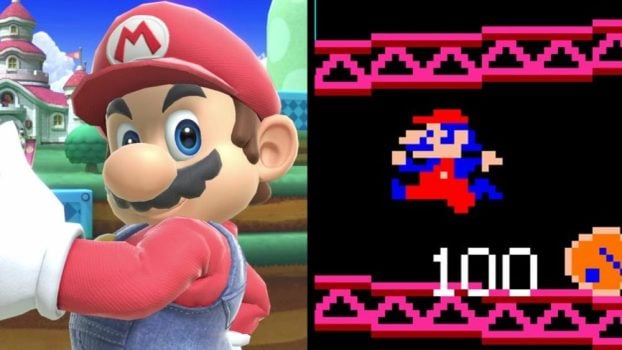
Mario - Donkey Kong (Arcade, 1981)

Donkey Kong - Donkey Kong (Arcade, 1981)

Link - The Legend of Zelda (NES, 1986)

Samus - Metroid (NES, 1986)

Dark Samus - Metroid Prime (GameCube, 2002)

Yoshi - Super Mario World (SNES, 1990)
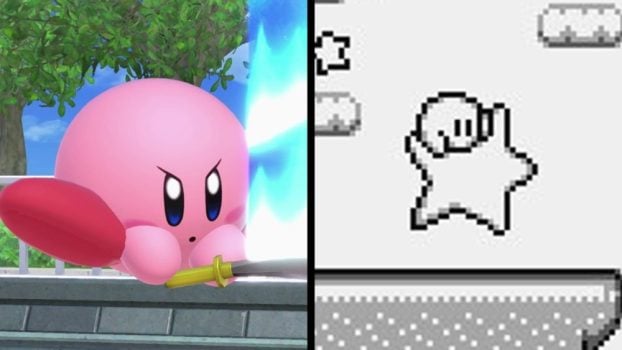
Kirby - Kirby's Dream Land (Game Boy, 1992)
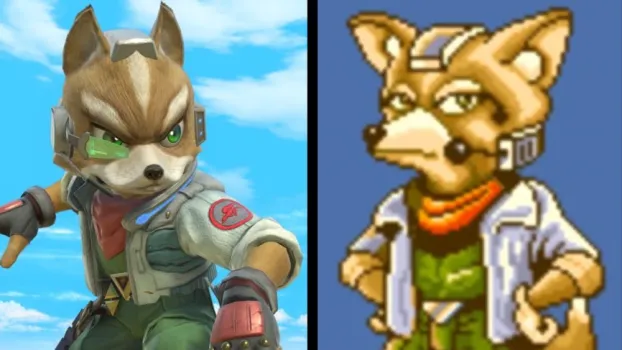
Fox - Star Fox (SNES, 1993)

Pikachu - Pokemon Red, Green & Blue (Game Boy, 1996)

Luigi - Mario Bros. (Arcade, 1983)

Ness - Earthbound (SNES, 1994)
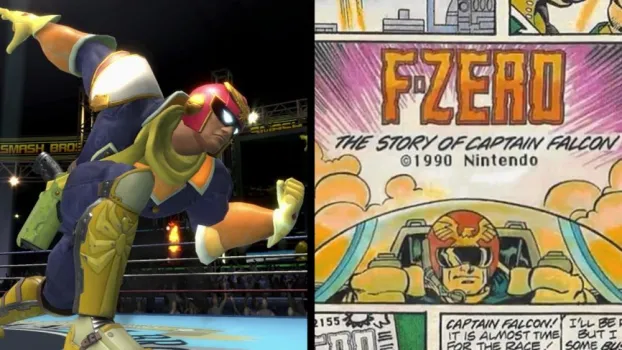
Captain Falcon - F-Zero (SNES, 1990)
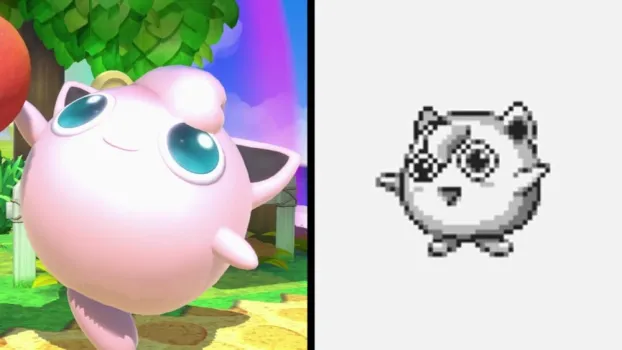
Jigglypuff - Pokemon Red, Green & Blue (Game Boy, 1996)

Peach - Super Mario Bros. (NES, 1985)

Daisy - Super Mario Land (Game Boy, 1989)
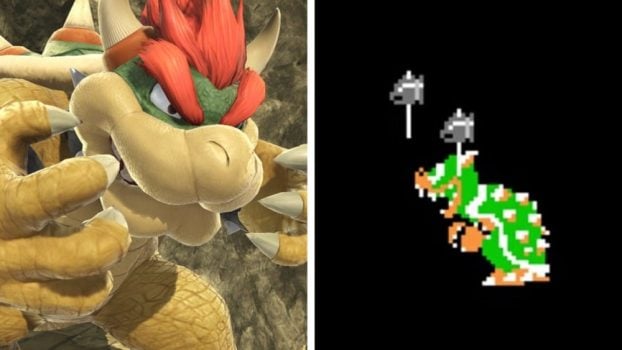
Bowser - Super Mario Bros. (NES, 1985)
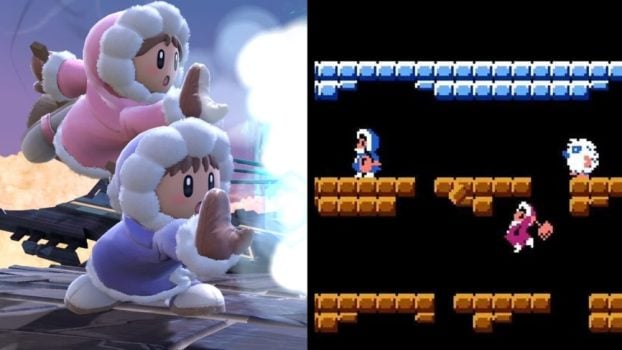
Ice Climbers - Ice Climber (NES, 1985)

Sheik - The Legend of Zelda: Ocarina of Time (N64, 1998)

Zelda - The Legend of Zelda (NES, 1986)

Dr. Mario - Dr. Mario (NES & Game Boy, 1990)
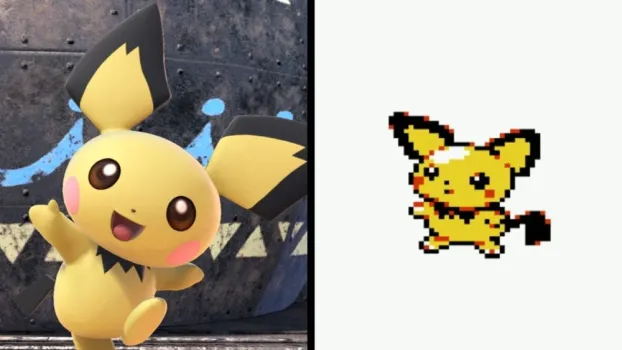
Pichu - Pokemon Gold & Silver (Game Boy Color, 1999)

Falco - Star Fox (SNES, 1993)

Marth - Fire Emblem: Shadow Dragon and the Blade of Light (Famicom, 1990)

Lucina - Fire Emblem: Awakening (3DS, 2012)

Young Link - The Legend of Zelda: Ocarina of Time (N64, 1998)

Ganondorf - The Legend of Zelda: Ocarina of Time (N64, 1998)

Mewtwo - Pokemon Red, Green & Blue (Game Boy, 1996)

Roy - Super Smash Bros. Melee (GameCube, 2001)

Chrom - Fire Emblem: Awakening (3DS, 2012)

Mr. Game & Watch - Ball (Game & Watch, 1980)

Meta Knight - Kirby's Adventure (NES, 1993)

Pit - Kid Icarus (NES, 1986)

Dark Pit - Kid Icarus: Uprising (3DS, 2012)

Zero Suit Samus - Metroid: Zero Mission (Game Boy Advance, 2004)

Wario - Super Mario Land 2: 6 Golden Coins (Game Boy, 1992)
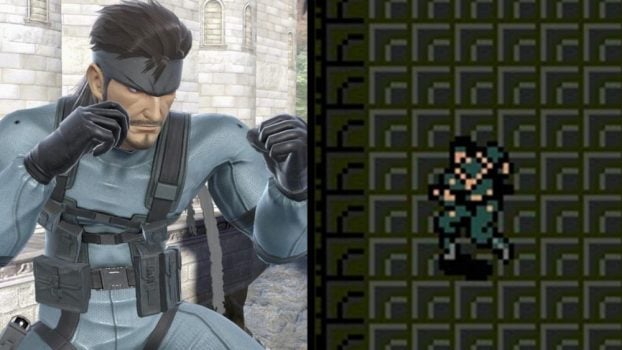
Snake - Metal Gear (MSX2, 1987)

Ike - Fire Emblem: Path of Radiance (GameCube, 2005)
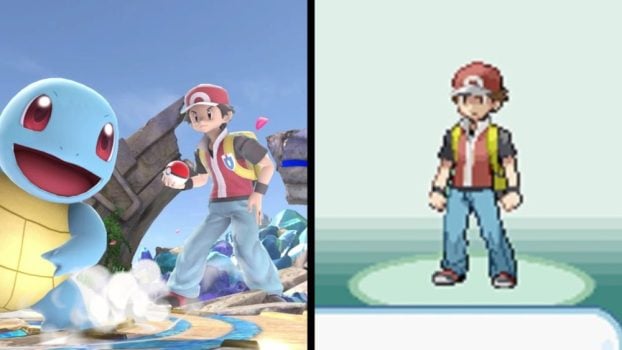
Pokemon Trainer - Pokemon FireRed & LeafGreen (Game Boy, 1996)

Diddy Kong - Donkey Kong Country (SNES, 1994)
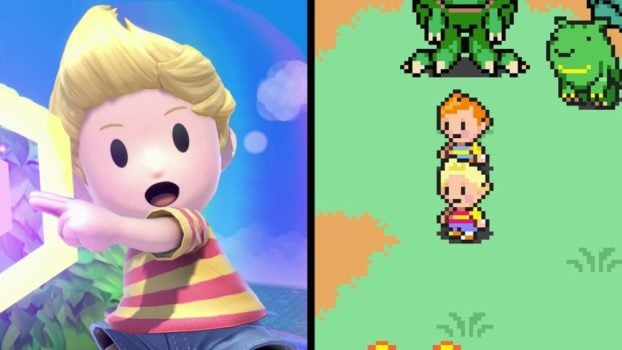
Lucas - Mother 3 (Game Boy Advance, 2006)

Sonic - Rad Mobile (Arcade, 1991)

King Dedede - Kirby's Dream Land (Game Boy, 1992)

Olimar - Pikmin (GameCube, 2001)

Lucario - Pokemon Diamond & Pearl (DS, 2006)

R.O.B. - IRL (1985)

Toon Link - The Legend of Zelda: The Wind Waker (GameCube, 2002)

Wolf - Star Fox 64 (N64, 1997)

Villager - Animal Forest (N64, 2001)

Mega Man - Mega Man (NES, 1987)

Wii Fit Trainer - Wii Fit (Wii, 2007)

Rosalina & Luma - Super Mario Galaxy (Wii, 2007)

Little Mac - Punch Out!! (NES, 1987)

Greninja - Pokemon X & Y (3DS, 2013)

Mii Fighter - Mii Channel (Wii, 2006)

Palutena - Kid Icarus (NES, 1986)

Pac-Man - Pac-Man (Arcade, 1980)

Robin - Fire Emblem: Awakening (3DS, 2012)
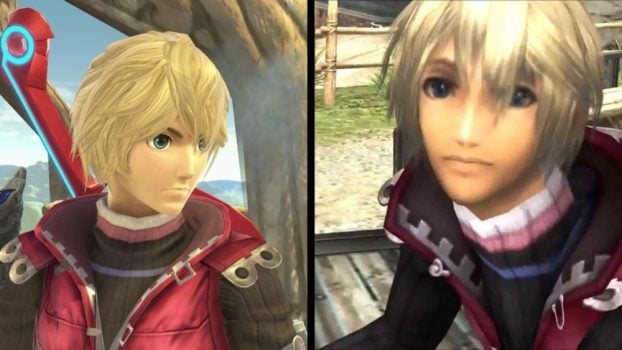
Shulk - Xenoblade Chronicles (Wii, 2010)

Bowser Jr. - Super Mario Sunshine (GameCube, 2002)

Duck Hunt - Duck Hunt (NES, 1984)

Ryu - Street Fighter (Arcade, 1987)

Cloud - Final Fantasy VII (PlayStation, 1997)

Corrin - Fire Emblem: Fates (3DS, 2015)

Bayonetta - Bayonetta (Xbox 360 & PS3, 2009)

Inkling - Splatoon (Wii U, 2015)
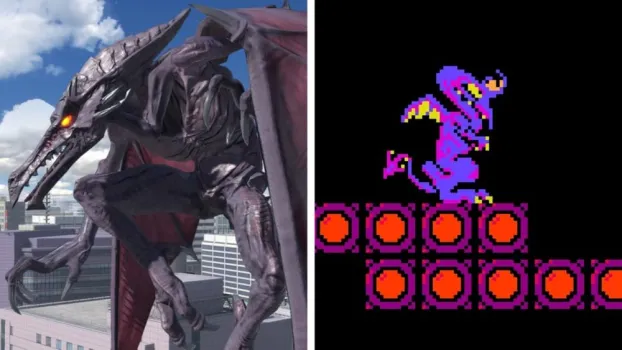
Ridley - Metroid (NES, 1986)

Simon - Castlevania (NES, 1986)

Richter - Castlevania: Rondo of Blood (PC Engine CD, 1993)
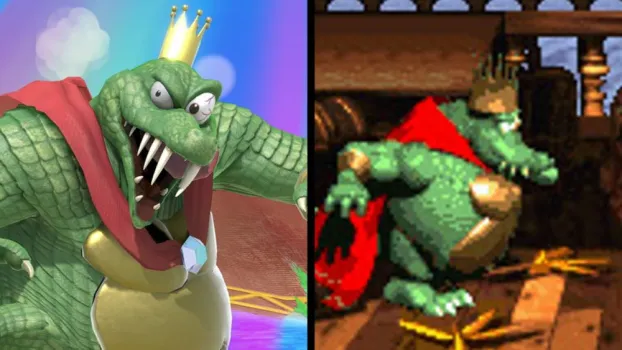













Updated: Aug 18, 2018 07:33 am